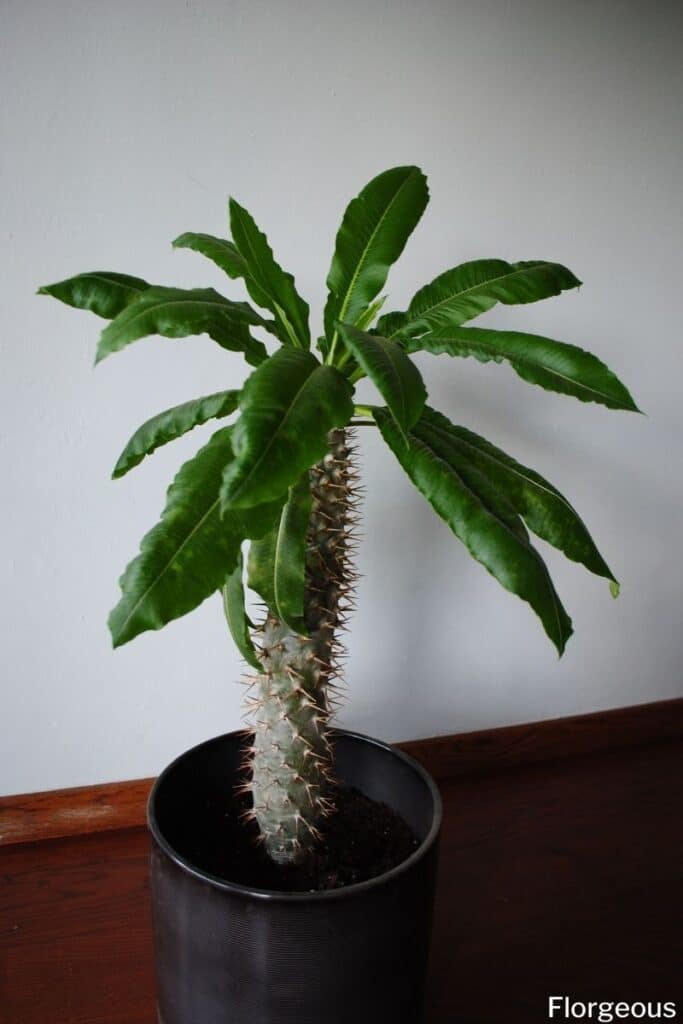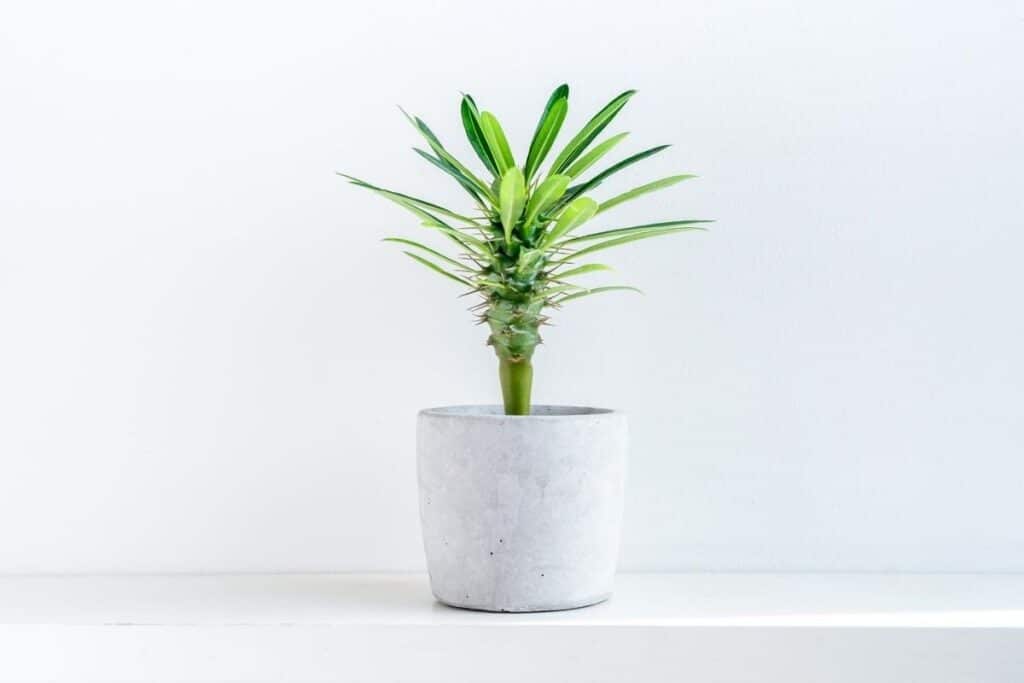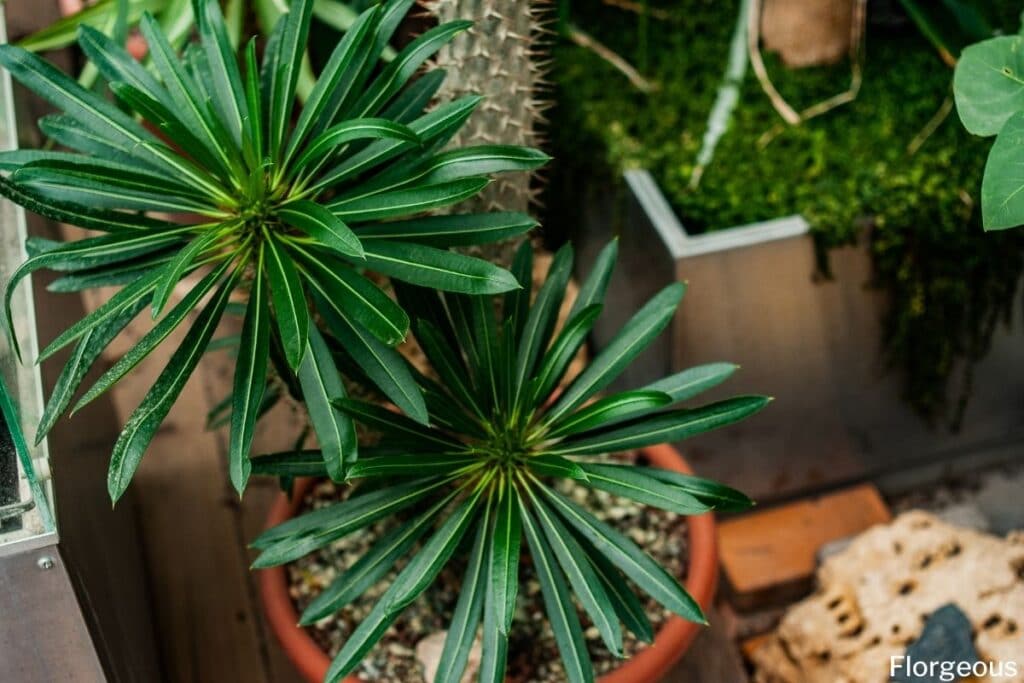The Madagascar Palm Tree is considered both a shrub and a succulent. Even though they look like a palm, they are not related to them! As its name suggests, this succulent is native to Southern Madagascar, and they are reasonably easy to maintain as they don’t have any special requirements.
The Madagascar palm is a beautiful tropical succulent with a spiny, silvery stem and palm-like green foliage. Outdoor madagascar palm looks amazing, but did you know they make a great houseplant too?
Read on for more on how to grow and care for these special spiny succulents indoors.
Plant Facts
The Madagascar palm is widespread in the hot and dry climate of tropical Madagascar (1). Despite its name, this unique plant is not actually a palm at all. It just gets this name because of the way its leaves grow crowded at the top of the stem.
In fact, this spiny plant looks a lot like a tall, thin pineapple. Although the plant’s succulent stems contain a toxic latex, you’re unlikely to come into contact with it because the plant is so well defended with spines.
Outdoor madagascar palms can reach a height of 20 feet (6m) but can be kept much smaller as a houseplant. These plants produce amazing white and yellow fragrant flowers, but only on mature plants that have reached a height of several feet and rarely on indoor plants.
| Scientific name | Pachypodium lamerei |
| Common names | Madagascar palm, Club foot plant |
| Family | Apocynaceae |
| Plant Type | Houseplant, Succulent |
| Height and Width | 4- 6 ft. tall (indoors), 2 ft. wide (indoors) |
| Origin | Madagascar |
| Flower colors | White |
| Foliage color | Mid-green |
| Sun Exposure | Direct sunlight |
| Soil Type & pH | Well-drained, mildly acidic to alkaline soil |
| Special features | Unique plant, large houseplant, succulent |
How to Grow a Madagascar Palm
The Madagascar palm tree can be grown both indoors and out, in containers or simply in the ground. The most important requirements are to provide it with good light and fast-draining soil. This is more easily managed in containers and that makes these plants a great choice for a unique and eye-catching houseplant.
These plants have a very distinct silhouette, filled with spines throughout the trunk. They can grow up to 24 feet in height outdoors and up to 2 feet wide, but don’t worry, you can also grow them as a succulent plant! This is why people often call this plant a Madagascar cactus.

Propagation
The Madagascar palm is a relatively easy plant to propagate. They can be grown from pre-soaked seeds and typically germinate in a matter of days. Spring is an ideal time to plant your Madagascar palm seeds.
These plants have an incredible ability to regrow when cut, which means they can also be grown from stem cutting. A specimen that has grown too tall can be turned into two or even 3 individual plants.
Soil
The Madagascar palm plant thrives in a sandy soil that drains quickly. A succulent or cactus soil mix would be ideal, as these are formulated for fast drainage.
Alternatively, you can improve the drainage of a standard potting mix by adding coarse sand or grit. Remember, proper drainage is crucial to prevent root rot, so ensure your container has drainage holes in the bottom to allow excess moisture to escape.
Pruning
The Madagascar palm plant requires very little pruning since the limited foliage it produces is crowded at the top of the stem. Usually, all that you may need to do is remove damaged or unhealthy leaves.
If your plant has grown a little too tall, you will need to cut the main stem to shorten the plant. This may seem like a rather drastic move, but these plants grow back very well, and the section you have cut off can be re-potted to create yet another beautiful houseplant. Additionally, when propagating young Madagascar palms, ensure that the cuttings have sufficient root development before transplanting them into new pots.
These plants are rather sensitive to fungal attacks, so be sure to sterilize the blades of your cutting tool before working on the plant. Remember, the sap of this plant is toxic, so take steps to keep animals, children, and uninformed persons away from the plant after pruning (2). Your cutting tools should also be washed and disinfected at this time.
Repotting and Transplanting
If you wish to keep your Madagascar palm limited in size for indoor growth, leaving the plant root bound will reduce its growing capacity. Your plant will survive this way as long as you can provide it with the water and nutrition it needs. In this case, you can simply replace the topsoil when necessary.
For plants that are still growing and need to be repotted, choose a larger clay pot with a stable base as they can become top-heavy as they grow. The stem of the Madagascar palm is covered in vicious spines, so great care should be taken when working with these plants. Leather gloves will be very useful, as well as a heavy jacket and protective glasses if you have them.
How to Care for a Madagascar Palm Tree
The Madagascar palm is a very low-maintenance houseplant. Provided you are growing it in a sunny spot with well-drained soil and not too much water, you will be free to enjoy this interesting species. Read on for details
Water
This plant will grow best when provided with regular water during the summer growing season. Wait for the soil to dry out somewhat between watering the plant, however.
During the cooler months when the plant is inactive, water should be provided very sparingly since the succulent stem holds all the moisture necessary for survival.

Sunlight
The Madagascar palm thrives in full sun, so you should position it in the sunniest spot possible. A plant that does not get access to enough light will grow tall and thin.
A spot near a large south-facing window would be ideal. Many growers keep this plant outdoors during the summer growing season and overwinter madagascar palm indoors.
Temperature and Humidity
This plant is adapted to live in a fairly warm climate, thriving in hot, dry conditions. Humidity is therefore not an issue at all. These plants are frost tender, however, and ideally should not be exposed to temperatures below about 50°F (10°C). They will survive outdoors in USDA hardiness zones 9-11.
In climates with a marked difference between warmer and slightly cooler temperatures, this plant will be deciduous or semi-deciduous, dropping its leaves in the fall before resprouting in the spring.
Fertilizer
Feeding your plants at the start of spring and summer will increase their growth rate and vigor. These slow-growing plants are not particularly heavy feeders though so don’t over-fertilize them. A diluted houseplant fertilizer designed for succulents will do fine, just be sure to follow the instructions specific to your product.
Pest and diseases
Madagascar palms are not particularly sensitive plants, but they can be affected by a few common houseplant problems.
Root rot can be a serious issue for plants grown in poorly drained soils or containers without drainage holes. The succulent stems of the Madagascar palm are very sensitive to infection after injury, so always treat these plants with care.
Overfertilizing your plants can lead to a build-up in the soil and result in dying leaves or dried leaf tips. When it comes to pests, keep a lookout for aphids. Madagascar palms are generally deciduous plants, so don’t be alarmed if the leaves drop in the cold season, they will regrow when the days get longer.
FAQ
Here are some of the most asked questions regarding the Madagascar Palm succulent or tree:
How often do you water Madagascar Palm?
Madagascar Palms should be watered sparingly, allowing the soil to dry out slightly between waterings. Water thoroughly when the top inch of soil feels dry, but be cautious not to overwater as they are susceptible to root rot.
Why is my Madagascar Palm dying?
Madagascar Palms may be dying due to various reasons such as overwatering, underwatering, inadequate sunlight, pests, or diseases. Check the soil moisture, adjust watering practices, ensure proper sunlight exposure, inspect for pests, and consider repotting if the root system is unhealthy.
How do you get Madagascar Palms to bloom?
Madagascar Palms typically bloom when they reach maturity, which can take several years. Ensure they are provided with adequate sunlight, appropriate temperatures, and well draining soil. While indoor plants may not bloom as readily as those grown outdoors, providing optimal growing conditions can encourage flowering.
Why are the tips of my Madagascar Palm turning black?
The tips of Madagascar Palm turning black could be due to overwatering, underwatering, or environmental stress. Ensure proper watering practices, provide adequate drainage, avoid waterlogging the soil, and maintain consistent growing conditions to prevent issues with the plant’s health.
Conclusion
If you’re looking for a fascinating and unusual houseplant, the Madagascar palm makes a wonderful choice. These large succulents make quite a bold statement but are easy to care for, provided you have a bright and sunny place for them to call home.
Lastly, Madagascar Palm trees or succulents can look amazingly well if you combine them with other types of succulents so that you can have your favorites in your house while creating a lovely garden or indoor area.
*Image by depositphotos.com/tete_escape







